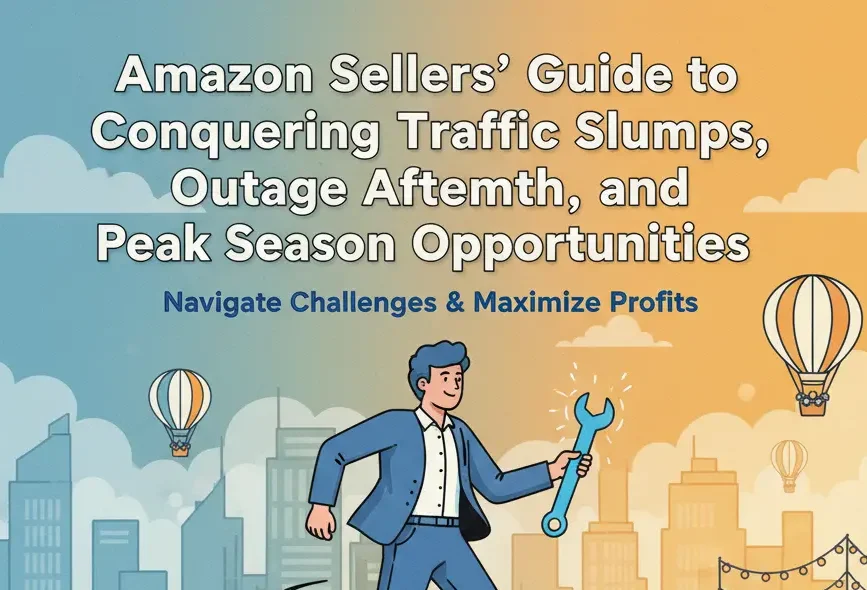Address
304 North Cardinal St.
Dorchester Center, MA 02124
Work Hours
Monday to Friday: 7AM - 7PM
Weekend: 10AM - 5PM

As an Amazon seller based in the U.S., you’ve likely felt the ripple effects of recent disruptions—from the large-scale outage to lingering traffic slumps, skyrocketing ACOS, and the ever-changing landscape of consumer behavior. In this guide, we’ll break down the challenges and equip you with actionable strategies to not just survive but thrive, especially as Black Friday, Cyber Monday, and new initiatives like Amazon Haul approach.
The recent Amazon outage sent shockwaves through the seller community. “Shopping carts vanished, ACOS spiked, and orders dried up overnight”—this wasn’t just a nightmare for many sellers; it was a stark reality. Even after the system was deemed “restored,” sellers reported ongoing anomalies: advertising campaigns ran amok, traffic remained elusive, and shopping carts disappeared without explanation.
One seller lamented, “My entire store’s shopping cart functionality went dark post-outage. I waited half an hour for support, and there was still no clarity.” Another shared, “ACOS hit 400% because I forgot to adjust budgets after the system crash—losses were devastating.” These stories highlight a harsh truth: system recovery doesn’t always translate to business recovery immediately.
Beyond the technical glitches, the outage exacerbated a pre-existing trend. Since this year’s Prime Day, Amazon’s overall traffic growth has slowed. For sellers, this meant rising advertising costs (ACOS) and declining conversion rates—issues that predated the outage but were amplified by it.
ACOS (Advertising Cost of Sale) has become a dreaded metric for many sellers lately. When the outage disrupted ad campaigns, sellers saw ACOS soar to unsustainable levels. But even in stable times, optimizing ACOS requires a nuanced approach.
Deloitte’s latest holiday spending survey paints a cautious picture: 57% of U.S. consumers expect the economy to weaken in the next year—the most pessimistic outlook since 1997. On average, shoppers plan to reduce holiday spending by 10%, prioritizing discounts and promotional channels.
For Amazon sellers, this means:
As we approach Black Friday (November 20) and Cyber Monday (December 1, 2025), Amazon sellers are in a unique position—recovering from an outage while gearing up for the busiest shopping period of the year. Here’s how to align your strategy:
While Amazon Haul is currently live in Japan, it signals Amazon’s continued focus on budget-friendly shopping experiences. For U.S. sellers, this is a reminder to prioritize value and affordability in your offerings. Consider how you can position your products as “haul-worthy” deals—items that offer significant value for their price—even in the U.S. market.
To navigate these challenges, adopt a multi-pronged approach:
If you’re an Amazon seller struggling with traffic slumps, ACOS management, or peak season prep, don’t navigate these challenges alone. Our team of eCommerce experts specializes in Amazon advertising, outage recovery strategies, and peak season optimization. Contact us today for a free consultation to create a tailored plan that boosts your visibility, conversions, and profitability—even in the most turbulent markets.
A1: Recovery timelines vary, but most sellers see gradual improvement within 1–2 weeks. However, proactive steps like ad optimization and product page refreshes can speed up this process.
A2: A healthy ACOS depends on your profit margins and industry, but most sellers aim for 20–30%. To lower ACOS, refine keyword targeting, optimize product listings for conversions, and test different ad placements.
A3: Focus on offering clear, compelling discounts, bundle products for added value, and emphasize affordability in your marketing. Also, consider extending promotional periods to capture shoppers over multiple days.